An assessment of the demand for DDT (A case study for Zambia)
Samuel F. Banda1 * and Aloysius Y. Mundia1
DOI: http://dx.doi.org/10.12944/CWE.4.2.05
The use of DDT for malaria vector control in indoor residual spray (IRS) is increasingly becoming the solution to the effective sustainable reduction in malaria prevalence. In Zambia, the Ministry of Health (MoH), Public health departments in the local authorities and even mining companies opt to use DDT in IRS. On its part, DDT, as a chemical, has well documented historical side-effects that are perceived to be hazardous to both human health and the environment. DDT use is severely restricted by the Stockholm Convention (SC) while the World health Organization (WHO) encourages efforts into finding alternatives. Preference for DDT stems from its long residual effects compared to other alternatives. This implies DDT has a cost reduction advantage. This study reflects the dilemma in attempts to reduce malaria using DDT and the need to adhere to the Stockholm Convention to which Zambia is a Party.
Copy the following to cite this article:
Banda S.F, Mundia A.Y. An assessment of the demand for DDT (A case study for Zambia). Curr World Environ 2009;4(2):293-298 DOI:http://dx.doi.org/10.12944/CWE.4.2.05
Copy the following to cite this URL:
Banda S.F, Mundia A.Y. An assessment of the demand for DDT (A case study for Zambia). Curr World Environ 2009;4(2):293-298. Available from: http://www.cwejournal.org/?p=963
Download article (pdf)
Citation Manager
Publish History
Select type of program for download
| Endnote EndNote format (Mac & Win) | |
| Reference Manager Ris format (Win only) | |
| Procite Ris format (Win only) | |
| Medlars Format | |
| RefWorks Format RefWorks format (Mac & Win) | |
| BibTex Format BibTex format (Mac & Win) |
Article Publishing History
| Received: | 2009-06-18 |
|---|---|
| Accepted: | 2009-08-29 |
Introduction
Pesticides are chemicals that have widely been acknowledged to be useful to man in a variety of ways that include a sure grantee for food supply via control of unwanted weeds and pests, safeguard for public health via eradication or reduction of harmful pests, to protection of buildings from termite attack and so on.
DDT, referred to according to its trivial name, Dichloro Diphenyl Trichloroethane, as a chemical, is classified as an organochlorine, or chlorocarbon; that is, an organic compound containing at least one covalently bonded chlorine atom- with the structure given below1.
DDT is traded for under many names such as Anofex, Cesarex, Chlorophenothane, Dedelo, p,p-DDT, Dichlorodiphenyltrichloroethane, Dinocide, Didimac, Digmar, ENT 1506, Genitox, Guesapon, Guesarol, Gexarex, Gyron, Hildit, Ixodex, Kopsol, Kybosh, Neocid, OMS 16, Micro DDT 75, Pentachlorin, Pennsalt, Puritan, Rukseam, R50, and Zerdane.
The wide structural variety and divergent chemical properties of this class of compounds led to a broad range of uses.
Many types of organochlorines have significant biological activities and toxicity to plants and/or animals, including humans. For example, many powerful and effective insecticides are organochlorines. Common examples include DDT, 2,4 dichlorophenoxy acetic acid(2,4 D), dicofol, heptachlor, endosulfan, chlordane, mirex, and pentachlorophenol. Dioxins, produced when organic matter is burned in the presence of chlorine; and, some insecticides such as DDT are persistent organic pollutants which pose dangers to the environment.
Some pesticides have been notorious and their adverse effects on human and the environment have earned them the term 'the dirty dozen'. This group of chemicals that include intentionally and unintentionally produced compounds have long captured world interest and they make the basis of the 2002 Stockholm Convention on Persistent Organic Pollutants (POPs). The dirty dozen are Aldrin, Chlordane, Dieldrin, DDT, Endrin, Heptachlor, Hexachlorobenzene, Mirex, Polychlorinated bipenyls (PCBs), Dibenzo-p-dioxins, Dibenzofurans, and Toxaphene. These compounds have the following characteristics: they have long half lives, they bioaccumulate in human and animal fatty tissues, are resistant to environmental degradation and are capable of long-range transportation2.
DDT has a half life of 56 days in lake water and approximately 28 days in river water where the slow processes of loss and degradation including runoff, volatilization, photolysis and biodegradation (aerobic and anaerobic) produce breakdown products (DDE (1,1-dichloro-2,2-bis(pdichlorodiphenyl) ethylene) and DDD (1,1 dichloro- 2,2-bis(p-chlorophenyl) ethane), which are also highly persistent and have similar chemical and physical properties3. The sum of these products together is known as total DDT. DDT and its metabolic products DDE and DDD magnify through the food chain.
The effects of DDT on human health were, in the past, disputed since studies carried out elsewhere had yielded conflicting results. However, no such studies have been carried out in Zambia. Suffice to say though, there are more documented studies which related to our local situation, and may provide heightened caution to the continued use of DDT, and elevated quantities in use in IRS for instance,
• A study of malaria workers who handled DDT occupationally found an elevated risk of cancers of the liver and biliary tract. Another study has found a correlation between DDE and liver cancer in white men, but not for women or black men. An association between DDT exposure and pancreatic cancer has been demonstrated in a few studies, but other studies have found no association. Several studies have looked for associations between DDT and multiple myeloma, and testicular, prostate, endometrial, and colorectal cancers, but none conclusively demonstrated any association4.
• In areas where DDT is used for malaria control, infants can be exposed via breast milk in levels that exceed WHO acceptable daily intake values for DDT5,6.
• A 2007 study documented decreases in semen quality among South African men from communities where DDT is used to combat endemic malaria. The researchers found statistically significant correlations between increased levels of DDT or DDE in blood plasma and decreases in several measures of semen quality including ejaculate volume, certain motility parameters, and sperm count. The same researchers reported similar results in 2006 from a study of men in Mexico7,8.
For example, mid-twentieth century overuse of DDT, which accumulates in animals, resulted in the severe decline of some bird populations.
The presence of pesticide residues, including DDT, has been reported in the fresh waters of Africa, America and Europe as shown in Table 1 below9:
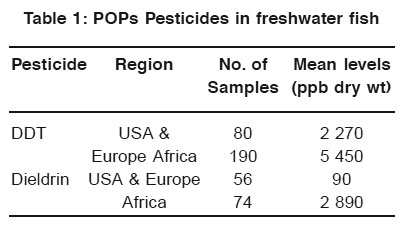 |
Table 1: POPs Pesticides in freshwater fish Click here to view table |
The environmental and health impacts of DDT and other biocides cannot be overlooked and have led to their limited or severely restricted use and in some countries total exclusion.
We have been tracking one of the POPs compounds in Zambia namely, DDT. This report focuses on the dilemma this POP is bringing to the country as data shows that its demand and usage is ever increasing. The Stockholm of Convention recommends restricted use of DDT in Article 3. Parties to the Convention are expected to scale down usage and to find suitable alternatives. DDT is allowed for use in malaria vector control, particularly in indoor residual spray (IRS), in accordance with the provisions of Part II of Annex B of the Convention10.
Zambia does not manufacture DDT but its demand for the chemical is approaching alarming levels and the search for alternatives10 does not appear to be yielding positive results. In this paper we demonstrate the dilemma of wanting to scale down malaria prevalence via the use of DDT.
Results and Discussion
We have carried out a survey on the demand for DDT in the country, tracing historical usage back to the 1970s when the chemical was used mainly as an agrochemical. Data collection included the need to establish both current and past uses of DDT; distribution patterns in the more recent past, handling methods for DDT in the areas of application; determination of the availability of other alternative chemicals, as well as other interventions and methods which have been used in instead of DDT. Table 1; and Charts 1and 2 below show the number of tonne DDT imported into the country for use, per province since the year 2000, while Table 3 shows the diversity of institutions that are demanding the use of DDT by province11,12.
The rising demand for DDT in recent years has a short history stretching back to the year 2000. Otherwise, activities involving DDT in the country were dead from the 1980s till then. The original use of DDT had been in agriculture where its use has, eventually, been banned. In recent years DDT has been used for disease vector control. In Zambia the rediscovery of DDT started in the year 2000 when companies operating largely on the mines in the Copperbelt province, ordered six tonne of the chemical for spraying in miners' houses. Other sectors in government soon joined in to order more of DDT specifically for IRS. The ministry of health in particular, is responsible for the sudden spread of the demand on DDT, with the Local authorities coming second (Table 3). It can be shown from Table 2; and, Charts I and II, that there has been an almost a tenfold increase in the demand for DDT in the country.
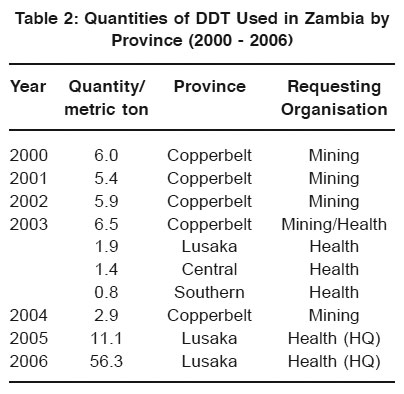 |
Table 2: Quantities of DDT Used in Zambia by Province (2000 - 2006) Click here to view table |
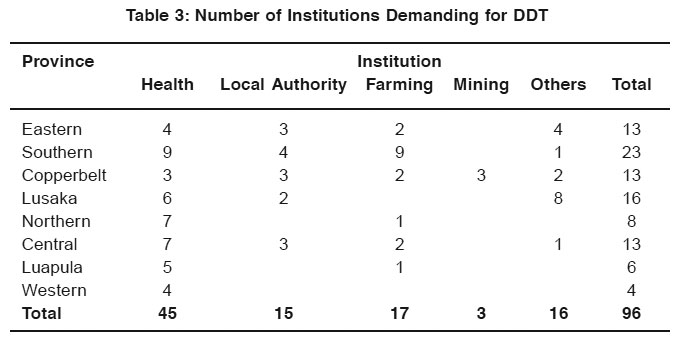 |
Table 3: Number of Institutions Demanding for DDT Click here to view table |
The DDT imported for use in IRS is packed in sachets; and, this has created health and environmental problems in terms of handling and disposal of both the chemical and the waste plastic materials. There are no clear guidelines on how the plastics sachets should ultimately be disposed of because burning would create other unwanted POPs in the form of dioxins and furans. The Environmental Council of Zambia, the local municipal and city authorities, the mining companies and the Ministry of Health have devised training strategies for handlers of DDT.
One immediate question that needs to be answered is, "does the exponential demand for DDT reflect an increase in the number of Malaria cases in the country?" Data on malaria prevalence in Zambia over the period 1998 to 2004 (Table 4) below indicates in the affirmative13.
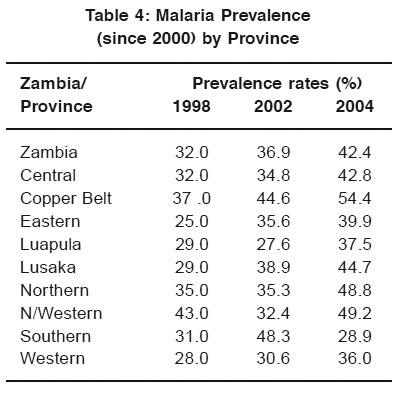 |
Table 4: Malaria Prevalence (since 2000) by Province Click here to view table |
More recent data from the Central Statistical Office shows a reasonable picture with regard to the effectiveness of measures, including IRS, on the ground 13,14,15 i.e. that:
• there was a significant drop in malaria prevalence levels, from 214.4 per 1000 in 2004 to 2000.0 per 1 000 in 2005; and also that
• there was a significant drop in the number of deaths due to malaria, from 4 765 in 2004 to 4 139 in 2005
From the data presented above, it is not clear by how much the use of DDT has helped in reducing prevalence and mortality rates. Therefore, more targeted research has to be undertaken to justify further use of DDT.
The Stockholm Convention advocates for the use of alternatives to DDT; and, in Zambia the most likely candidates are pyrethroids but their usage suffers from their having been of short residual effects and limited impact on the malaria vector. In the Zambian press, DDT has been having its own share of beating from community residents. IRS is said to trigger home invasions by cockroaches as they flee from their obscure hiding places; also, some residents claimed that residual vapour from the chemical caused them to develop itching that led to scratching of their bodies16.
The prevention strategy for malaria control in Zambia is multi-pronged with four major components, in addition to the use of IRS. As for the diversity of other measures that are currently in use as alternatives to DDT, the following alternatives the use of insecticide treated nets (ITNs); larviciding; Environmental Management, and Malaria case management.
Chemical alternatives to DDT include organo-phosphates, carbamates and pyrethroids. Among the many substances found on the market are the following, listed in Table 5 below. Some products (icon and karate), based on similar active ingredients carry different trade names- a possible, and serious source of confusion, as we know that chemical hazard communication comprehension levels are not high in Zambia. In a study undertaken in 2001 with respect to the Zambian GHS situation analysis, it was established that:
• several labels from outside the country are used in Zambia;
• tools such as Material Safety Data Sheets rarely reach workers on the shop floor;
• label elements are generally poorly understood; and that
• institutional structures and political will relating to chemical hazard communication are generally inadequate17.
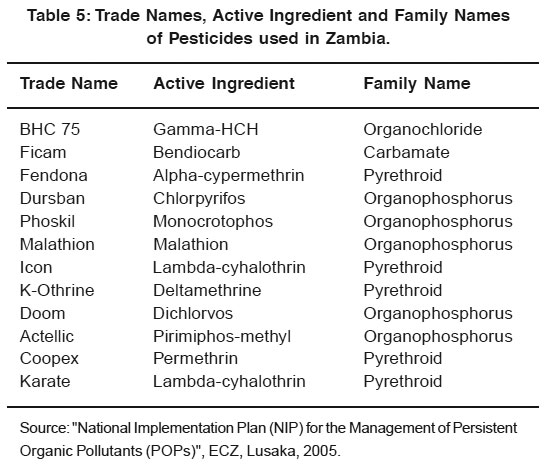 |
Table 5: Trade Names, Active Ingredient and Family Names of Pesticides used in Zambia. Click here to view table |
This study demonstrates that Zambia is most likely not to enter into reverse gear given its affinity for DDT, especially coupled with its current inertia to pursue appropriate alternatives.
Acknowledgement
We wish to thank the United Nations Environment Programme (UNEP) for the support to the Environmental Council of Zambia (ECZ) for which organization this study was done.
References
1. Ramamoorthy S et al (Lewis Publishers, Boca Raton), "Chlorinated Organic Compounds in the Environment" (1997).
2. http://www.3dchem.com/molecules.asp
3. http://www.atsdr.cdc.gov/toxprofiles/tp35- c6.pdf
4. Rogan WJ, Chen A , "Health risks and benefits of bis(4-chlorophenyl)-1,1,1- trichloroethane (DDT)". Lancet, (2005) 366(9487):763-73.
5. Bouwman H Sereda B, Meinhardt HM . "Simultaneous presence of DDT and pyrethroid residues in human breast milk from a malaria endemic area in South Africa". Environ. Pollut. (2006) 144(3): 902-17.
6. Ntow WJ, Tagoe LM, Drechsel P, Kelderman P, Gijzen HJ, Nyarko E. "Accumulation of persistent organochlorine contaminants in milk and serum of farmers from Ghana". Environ. Res. (2008) 106(1): 17-26.
7. Aneck Hahn NH, Schulenburg GW, Bornman MS, Farias P, de Jager C, "Impaired semen quality associated with environmental DDT exposure in young men living in a malaria area in the Limpopo Province, South Africa". J. Androl.(2007) 28(3): 423-34 .
8. De Jager C, Farias P, Barraza-Villarreal A, et al, "Reduced seminal parameters associated with environmental DDT exposure and p,p'-DDE concentrations in men in Chiapas, Mexico: a cross-sectional study". J. Androl. (2006) 27(1): 16-27.
9. Wiktelius, S, Edwards, C A., "Organochlorines Residues in African Fauna", Rev: Environ. Contam. Toxicol. (1971-1995) 151: 1-37.
10. UNEP Chemicals, Paris, "Stockholm Convention on Persistent Organic Pollutants" (2001).
11. Central Board of Health, Lusaka, Zambia, "Guidelines for Epidemic Preparedness, Prevention and Control of Malaria in Zambia" (2004).
12. Tver F David (Industrial Press Inc., New York, "Dictionary of Dangerous Pollutants" (1981).
13. CSO, (November 2004, Lusaka), "Living Conditions Monitoring Survey Report 2002/ 3".
14. CSO, (December 2005, Lusaka), "Living Conditions Monitoring Survey Report 2004".
15. Ministry of Finance and National Planning, (March, 2006, Lusaka), "Economic Report 2005".
16. The POST Newspaper, April 15, 2008.
17. Banda S F et al, "CHC/GHS Country Situation Analysis - Zambia (2001).






